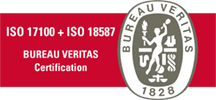Contract translation services that protect your business and deadlines
Contract translation services done right prevent costly disputes and delays. We combine legal expertise, rigorous QA, and certified options to keep your deals moving.

Table of Contents
Why precise contract translation matters
Ambiguity in a translated clause can shift risk, extend liability, or void an agreement. That is why our contract translation services are delivered by legal-savvy linguists who work to the intent of each provision, not just the words. We align terminology with applicable law and the deal’s commercial logic, so the translated document reads as if it were drafted in the target language.
We also build term bases for parties, definitions, and governing-law references. This keeps all agreements consistent across subsidiaries and vendors. For perspective on how legal nuance impacts outcomes, see our overview of specialized Legal Translation.
How our contract translation services reduce risk
First, we scope the document set and confirm governing law, jurisdiction, and signature formalities. Second, we translate using vetted legal translators and a two-step review. Third, we run targeted QA for cross-references, numbering, and exhibits—crucial in MSAs and share purchase agreements. Finally, a senior reviewer validates style and definitions across the bundle. For broader service context, visit our Translation Services page, and our practical guide on Legal translation services you can trust.
Where filings require certified output, we can add certification and notarization. See our dedicated page on Certified Translations and the explainer Certified Translation Guide. In the UK, guidance on certification wording is described by GOV.UK’s rules on certifying a document. For Companies House filings, the VT01 note on how to certify a voluntary translation clarifies when a certificate is appropriate.
Our contract translation services workflow
We keep the process simple and defensible:
- Discovery & triage — Identify contract type (e.g., NDA, SLA, SPA), target jurisdictions, and due dates.
- Team & terminology — Assign legal translators with domain fit; load a project glossary and previous bilinguals for consistency. Our continuous improvement approach is outlined in Zero Errors, Total Satisfaction.
- Translation & legal review — Two-step translation plus review, with attention to defined terms, schedules, and exhibits.
- Quality assurance — Automated and human checks for cross-references, numbering, annex alignment, and mandatory clauses.
- Certification (if needed) — Provide translator’s statement, company letterhead, and notarization when required by the receiving authority.
- Delivery — Clean, print-ready files in original layout, plus bilingual change log if requested.
For technical appendices, our team also handles domain-specific content; see Technical Translation.
Certified vs. legal translation: what you actually need
Not all matters require a certified translation. In commercial negotiations, a legally reviewed translation may suffice to inform the parties. For official submissions, regulators or registries may require certification or legalization. The GOV.UK page on certifying a document and the Companies House form VT01 for voluntary translations are good examples of context-specific requirements.
Our team will advise whether a legal translation with peer review is enough or whether a certificate is necessary. When certification is required, we include the translator’s statement, date, contact, and a confirmation that it is a true and accurate translation—aligned with local expectations and our internal Translation Services SOPs.
Languages, domains, and document types
We cover the major EU languages plus EN↔PT and EN↔ES for cross-Atlantic deals. Across industries, we frequently translate:
- Sales & procurement: MSAs, SOWs, framework agreements, SLAs.
- Corporate: SPAs, shareholders’ agreements, bylaws, board minutes.
- HR & compliance: employment contracts, codes of conduct, DPAs.
- Real estate & infrastructure: leases, EPC/turnkey contracts, concession agreements.
- Technology & IP: license agreements, SaaS terms, DPAs, DPIs, and annexes.
For risk-heavy matters, our guidance on Legal Translation explains how we align terminology with applicable law and industry usage.
Turnaround times, pricing, and confidentiality
Deadlines often hinge on signing dates or regulatory filings. We size teams to your timeline and coordinate parallel workflows for annexes and exhibits. Pricing is transparent: page-based for scans, word-based for editable files, with options for rush service. If you need long-term predictability, we set up glossaries and discounts for recurring volumes via our Translation Services framework.
Confidentiality is built-in. Access is restricted to your project team, and NDAs are available on request. Our assurance philosophy is detailed in Zero Errors, Total Satisfaction, and our blog on Legal translation services you can trust shows how we operationalize that commitment.
How to prepare files for a smooth project
Well-prepared inputs save days on layout and corrections:
- Send editable files (DOCX, XLSX, PPTX). For scans, include searchable PDFs when possible.
- Provide reference materials: previous bilinguals, term lists, or house style.
- Flag critical clauses (e.g., indemnities, caps, liquidated damages) and any preferred translations for defined terms.
- Indicate who will sign and where the translation is to be used; this determines whether certification is required.
For a deeper primer, see our Certified Translation Guide and service overview for Certified Translations.
FAQ
Q1. When do I need a certified translation for a contract?
Certification is typically required when a translated contract will be filed with a public authority or used in legal proceedings. Examples include articles filed with a company registry, documents for immigration matters, or translations requested by a court. The goal is to add a formal attestation that the translation is true and accurate.
If your translation is for negotiation between parties, a legally reviewed translation is often enough. We assess the destination authority and purpose. GOV.UK’s guidance on certifying a document and Companies House VT01 illustrate how requirements depend on the filing. We’ll advise the minimal formality that still meets the target authority’s expectations.
Q2. What makes a contract translation “legally reliable”?
Beyond language skill, legal reliability comes from process: experienced legal translators, a second reviewer, and targeted QA on definitions, cross-references, numbering, and annexes. Consistent terminology is essential for clauses like limitation of liability or governing law.
We also consider layout and evidential use: headers and pagination must match, and any handwritten notes or stamps should be reproduced or described. When certification is needed, we attach a translator’s statement with the elements the receiving body expects, ensuring the file is both readable and admissible.
Q3. How fast can you deliver without compromising quality?
Speed comes from smart resourcing, not cutting steps. We parallelize long contracts by section, maintain a shared glossary, and combine automated checks with human review. For short NDAs and addendums, same-day delivery may be possible; for complex SPAs or bundles with exhibits, we’ll propose phased deliveries to keep your timetable.
If you already have term lists or previous translations, share them upfront. Clean inputs reduce review cycles and allow us to commit to tighter schedules while preserving accuracy and consistency.
Q4. How do you price contract translation projects?
Editable files are usually priced per word; scanned or image-based files may be priced per page. Certification, notarization, and sworn elements—when required—are quoted separately. We’ll also note any layout recreation or complex tables that need DTP time.
For recurring work, we can create a rate card, set up translation memories to reduce costs on repeats, and agree service levels for rush jobs. The aim is predictability: you get transparent pricing and a process that scales with your pipeline.

